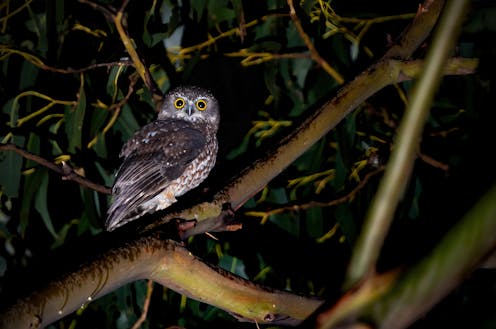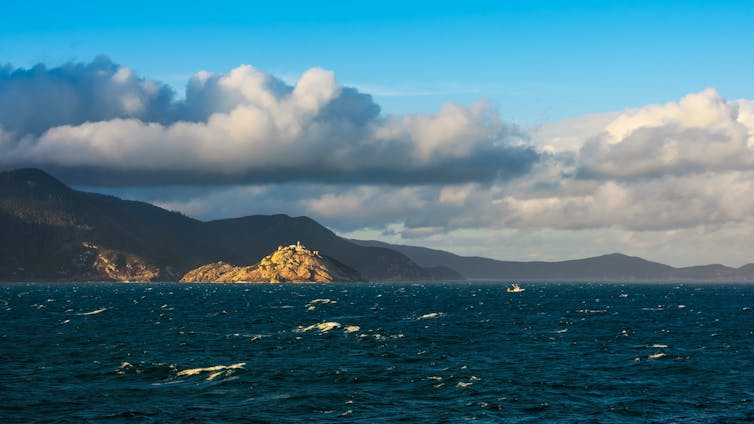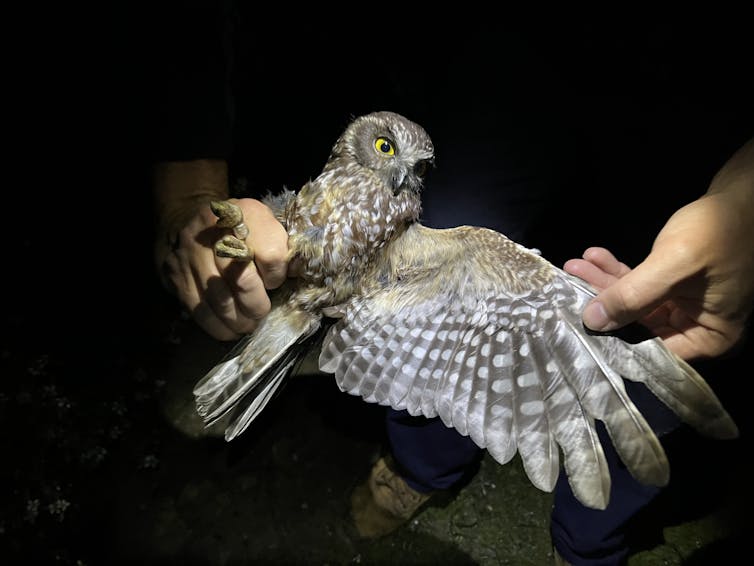
Every year, tens of thousands of land birds make a long flight across Bass Strait – the stretch of water separating Tasmania from continental Australia.
Well known for its high winds and rough seas, crossing Bass Strait is no small feat for these migrant land birds. Migration is stressful for birds, as they encounter inhospitable environments, predators, and weather changes while expending peak energy.
But how exactly do these birds traverse this daunting stretch of ocean?
Understanding this is more crucial than ever. New developments proposed in Bass Strait, particularly offshore wind farms, may introduce challenges for migrating birds. And until now, no one has looked closely at the movement pathways of these little migrants.
Our new research tracked the migration paths of Tasmanian boobooks, Ninox leucopsis, as they crossed from Victoria to Tasmania.
We found the Tasmanian boobook was indeed a regular migrant across Bass Strait – making it Australia’s only migratory owl. Rather than island-hopping, these small owls completed the roughly 250 kilometre flight across the strait in a single night, in one continuous flight.
These insights may help us protect birds in a rapidly changing world.

Tagging and tracking the Tasmanian boobook
As their name suggests, Tasmanian boobooks are common across Tasmania and were once considered endemic to the island. Over time, they were occasionally spotted in mainland Australia, with scattered records in Victoria and elsewhere.
In recent years, a more consistent pattern was revealed when keen birdwatchers discovered small numbers of these owls perched on Cape Liptrap, southeast of Melbourne, in spring. Could these birds actually be migrants about to make the Bass Strait crossing after winter on the mainland?
With thermal cameras, special nets, and lightweight miniature GPS-tracking devices in hand, we travelled to the southeast Victorian coast to catch five Tasmanian boobooks at these headlands.
Once we attached the tracking devices, we could follow their movements for up to three weeks before the tags failed and were dislodged.

Facinating findings
We found the Tasmanian boobook is Australia’s only migratory owl. In fact, it is what’s known as a “partial migrant”. This means while some birds of the species migrate, many other individuals remain in Tasmania year-round.
Three of our tagged birds departed southeast Victoria in October and November. They began their nonstop journeys at dusk and arrived in northern Tasmania early the following morning.
Two continued moving further inland to central Tasmania over subsequent nights and eventually settled at elevations of around 750 metres.
These observations suggest the migrating Tasmanian boobooks may be fleeing harsh winter conditions at high elevation areas. This phenomenon, known as altitudinal migration, has been observed in other Tasmanian birds such as the flame robin and crescent honeyeater.
We also discovered unexpected variety in the Tasmanian boobook migration patterns. Some birds left from Cape Liptrap and others from Wilsons Promontory, at the southern tip of Victoria.
They also flew at varying speeds under a surprising range of weather conditions, including headwinds upon departure. This is in an impressive feat for an owl, which weighs just 210–240 grams and probably undertakes the crossing by continuously flapping its wings.
New clues and questions about other Bass Strait migrants
Bird migration in the southern hemisphere is little-studied compared with northern hemisphere migration.
In Australia, movement patterns are particularly complex and variable due to the vast scale of the continental landmass, the variable geography such as mountains, deserts, and islands, and unpredictable climate.
At least 24 species migrate across Bass Strait. They range from songbirds and raptors to the critically endangered orange-bellied parrot and swift parrot.
Much of what we know comes from limited land-based observations. The Tasmanian boobooks we tracked give us just a small insight into the many migratory journeys across Bass Strait.
However, the variation we observed in just three migratory tracks for a single species raises questions about other Bass Strait migrants.
Are islands less crucial as stopover points than previously thought? Even for species like the orange-bellied parrot, which does use islands, it remains plausible many individuals might cross Bass Strait in a single non-stop flight.
These unanswered questions about bird movement across Bass Strait is not just a matter of curiosity.
Hazards old and new
Migratory birds are exposed to a greater range of threats than non-migratory birds. Crossing Bass Strait means risking inclement weather, artificial lighting, and collision with boats or oil rigs. Now, new developments may also present novel challenges.
Australia is rapidly expanding its renewable energy sector, including offshore wind.
Several areas in Bass Strait have been declared by the federal government as priority areas for wind farm development and many projects are already being planned.
These developments are essential for reducing emissions and combating climate change. But how do we balance the necessary transition to clean energy, while minimising direct harm to biodiversity?
Offshore wind farms can displace birds from their routes, or worse, introduce collision risks.
Environmental assessments are a mandatory part of wind farm development in Australia, but they need to be informed by robust ecological data.
Understanding the basic ecology of land-bird migration is crucial. We need to know where the threats to migratory birds are highest, which species are at risk of collisions, and how to mitigate these threats as the transition to renewable energy continues.
Jessica W. Zhou's research group works with various stakeholders to address the threat posed by wildlife collisions with wind energy infrastructure. This includes contracts with wind farm developers, environmental consultancies, and DCCEEW and NOPSEMA, as the federal regulators of offshore wind. The research group has also received funding from environmental consulting firm Biosis.
Rohan Clarke's research group works with various stakeholders to address the threat posed by wildlife collisions with wind energy infrastructure. This includes contracts with wind farm developers, environmental consultancies, and DCCEEW and NOPSEMA, as the federal regulators of offshore wind. The research group has also received funding from environmental consulting firm Biosis.
This article was originally published on The Conversation. Read the original article.







